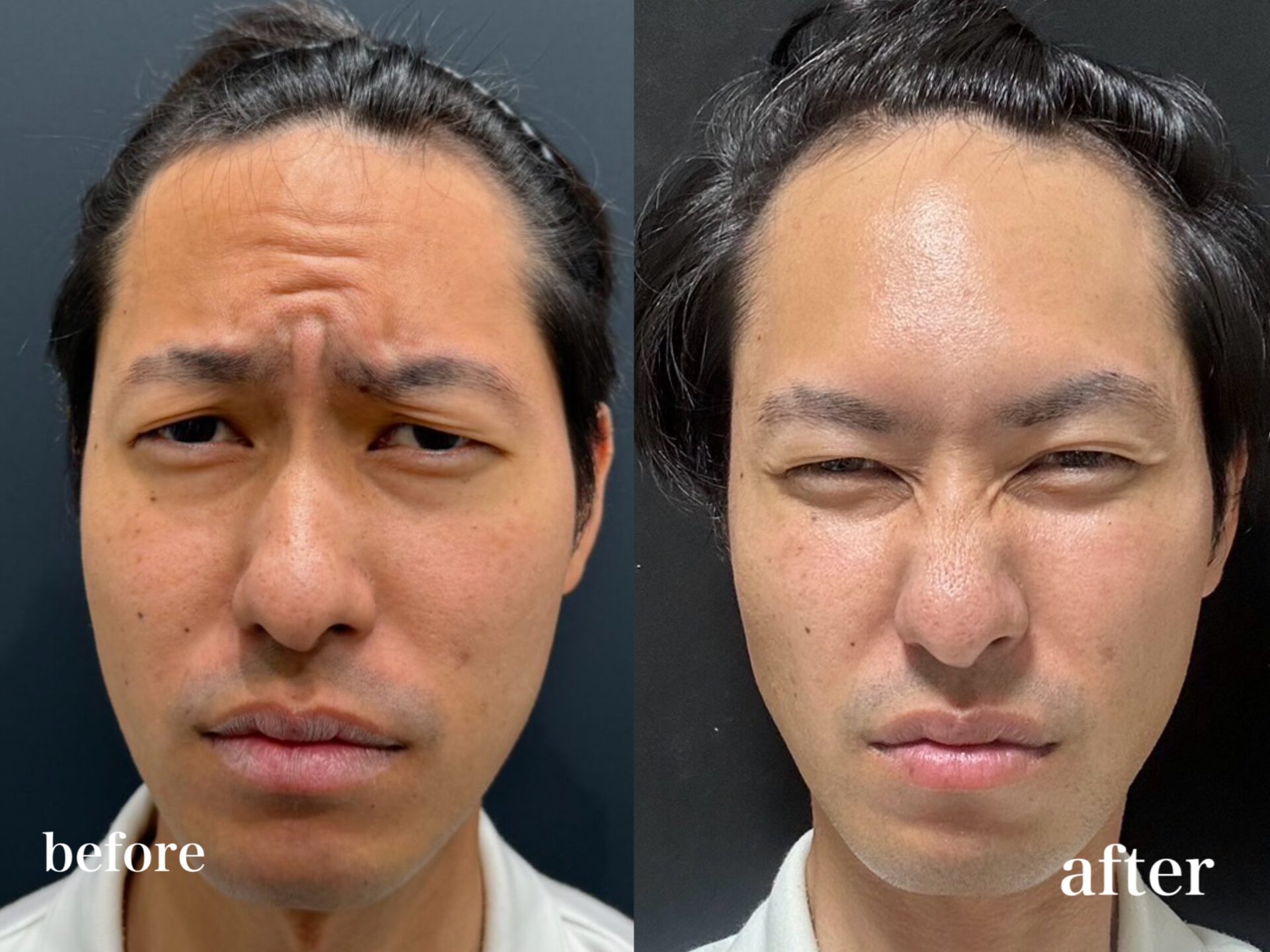
Effectiveness and Procedure of Frown Line Botox
Botox works by relaxing the corrugator supercilii (the muscle that furrows the brow) and the procerus (the muscle that lowers the brow), preventing the furrowing of the brow and the formation of frown lines. Typically, 12 to 20 units of Botox are injected into 5 to 6 areas of the forehead.
Botox Injection Method and Pain
For this procedure, I use a 34-gauge needle, which causes a slight pinch sensation 5 to 6 times. Most people do not use anesthesia, but nitrous oxide or numbing cream can be used for comfort.
Post-Treatment Recovery and Key Considerations
The effects of Botox become noticeable 3 days to 1 week after the treatment, with the full results seen 2 weeks post-injection. The effects generally last between 3 to 4 months.
Causes of Frown Lines and the Benefits of Botox Treatment
What Causes Frown Lines?
Frown lines are caused by the contraction of the corrugator supercilii and procerus muscles, which pull the brow inward or downward. The corrugator typically creates vertical lines, while the procerus causes horizontal lines.
Duration and Effectiveness of Botox
The Botox effect typically lasts between 3 to 4 months, during which time the muscles are relaxed and unable to form new frown lines.
Potential Drawbacks of Frown Line Botox
Botox prevents the ability to furrow the brow, so people whose professions require expressive facial movements (such as actors) should be cautious.
Choosing the Right Clinic and Pricing
How to Choose a Reliable Clinic:
Frown line Botox is a straightforward procedure that can be performed at many clinics. However, incorrect injection into the frontal muscles or orbital region can result in difficulty opening the eyelids. It is important to ensure the clinic uses safe Botox formulations to avoid complications. If any issues occur, you may have to wait for the Botox to wear off.
Cost and Additional Fees:
At our clinic, we use Allergan Botox, which is priced at 10,000 yen per treatment. There are no additional fees.
Pre-Treatment Consultation and Preparation
Points to Discuss in Consultation:
During your consultation, discuss with the doctor whether your frown lines are caused by the corrugator supercilii or the procerus muscles. Based on this assessment, Botox will be injected into the appropriate muscles in the necessary amounts.
Treatment Flow and Preparation on the Day of the Procedure:
During the consultation, confirm the muscle(s) that will be treated and the number of Botox units to be injected. After sanitizing the area, the injections are administered.
Anesthesia Methods and Their Effects:
Most patients do not require anesthesia, but nitrous oxide or numbing cream may be used.
Nitrous oxide will not eliminate pain completely but can make you feel light-headed and relaxed, reducing anxiety.
Numbing cream prevents the slight sting during injections.
Aftercare and Post-Treatment Considerations:
After the injection, once bleeding is stopped, the procedure is finished. There is no special aftercare required.
Makeup and Facial Care Post-Treatment:
You can resume your regular makeup and skincare routine after the treatment.
Effectiveness and Results from Photos of Actual Cases

You will be able to see a reduction in frown lines following Botox treatment. Many patients experience smoother, more youthful-looking foreheads.
Risks and Safety of Frown Line Botox Treatment
Possible Side Effects and How to Manage Them:
If Botox is injected too deeply into the frontal muscles or the orbital region, it could cause difficulty opening the eyes. To prevent this, inject Botox shallowly on the outside and deeper on the inside. One technique to avoid Botox entering the orbital area is to gently press the area while injecting.
Risk Management and Safety Considerations:
If you're unsure of the Botox product used or its source, it's important to ensure the product is from a trusted manufacturer. Low-quality Botox may lead to complications.
Knowledge of Allergic Reactions:
To date, allergic reactions to Botox are extremely rare, and most patients do not experience any adverse effects.
Yoshiko Kuno
